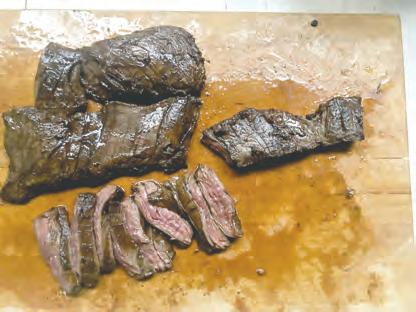B2 Monday, November 16, 2020 — DAILY REPUBLIC
Chef: great steak starts with sangria marinade Bloomberg In the wide world of cooking, steak is, ostensibly, one of the least complicated foods to prepare. Fanatics can and will go deep on the subject, but what’s basically required is a hot surface and the aptitude to take it to the doneness of choice with minimal intervention. And then there’s skirt steak, the simplest of cuts to cook. It’s so thin, it doesn’t require a meat thermometer to check for doneness; even if you wanted to use one, skirt steak isn’t thick enough to accommodate it. Instead, you just count the few minutes until it’s charred, then slice and serve. Joey Campanaro is a die-hard skirt steak fan. The chef-owner of the Little Owl on a scenic West Village corner in New York favors it for its intense, meaty flavor. The cut is from the diaphragm muscle in the chest area, near the liver, which adds a powerful hint of iron. He also appreciates it from a practical standpoint. Because his restaurant and kitchen are tiny, Campanaro likes the ease with which skirt steak is prepared; the meat cooks speedily over fire and then is sliced and ready to go. This makes it a great, unfussy dish to prepare at home. It’s good for dinner, says Campanaro, while working well for lunch or brunch, too. “Its not the heaviest of steaks, but it satisfies that crave,” he says. What makes this skirt steak recipe compelling is the sangria-styled marinade Camparano prepares. Studded with orange slices, the red wine mixture includes garlic and shallots that flavor the meat; the acidic wine and citrus also tenderize the beef, making the cut cook even faster. Another ingredient with benefits is honey: Besides infusing the steak, it enhances the cooking. “It’s the honey that accelerates the caramelization of the meat and gives it that excellent char,” says Campanaro. The result is a tender but chewy steak that has the perfume of red wine with an underlying sweetness. The marinated skirt steak is featured In Campanaro’s new Big Love Cooking: 75 Recipes for Satisfying, Shareable Comfort Food, with Theresa Gambacorta (Chronicle Books: $30). While the book includes recipes for such destination dishes as the Little Owl pork chop, it is fundamentally a love letter to his heritage. Campanaro devotes a chapter to the crafting of a major Italian American Sunday supper like the ones he grew up among in South Philadelphia. Included in that feast are Sunday gravy stocked with meatballs, braciole (steakwrapped, cured meat), as well as country-style ribs, Italian sausage, and pigs foot for special occasions. The recipe goes on for four pages and includes a sidebar on the importance of “stirring the gravy.” There are also “homemades,” as in pasta, made-from-scratch slider buns for meatballs, “old school salit” (as in, salad with iceberg lettuce), and rum cake. “I built the book around that meal,” says Campanaro. But the chef, who also trained with the illustrious Jonathan Waxman, doesn’t think the amount of time spent cooking defines the importance of a dish. “It can be Sunday gravy, it can be a skirt steak. Just make food that you want to share.” Sangria-Marinated Skirt Steak Serves 4 2 cups fruity red wine, such as Spanish Rioja ¼ cup honey 1 orange, skin-on, sliced into thin wheels 1 shallot, thinly sliced 3 garlic cloves, smashed 3 springs fresh thyme ¼ cup olive oil 1 ½ lb. skirt steak, fat and any sinew trimmed Kosher salt Freshly ground black pepper 2 tbsp. neutral oil Flaky sea salt In a non-reactive bowl or pot large enough to contain the marinade and the steak, combine the wine, honey, orange wheels, shallot, garlic, thyme, and olive oil. Place the steak in the marinade, cover tightly, and refrigerate for at least 6 hours and no more than 12 hours. Remove the steak from the marinade and cut into it 6- to-8-inch lengths that will fit in the skillet. Season generously with salt and pepper on both sides. In a large cast-iron skillet over high heat, warm the neutral oil until it shimmers. Gently place the steak in the skillet and cook until the underside is browned-don’t move it or touch it, just let it do its thing-about 2 minutes. Flip and cook until the other side is browned, too, for an additional 1 to 2 minutes, depending on the thickness of the steak. Transfer to a plate and let rest for 7 to 10 minutes before slicing it, so the juices don’t leak out. Slice the steak against the grain and transfer to a serving platter. Sprinkle the steak with Maldon sea salt flakes and additional pepper, if you like. Adapted from Big Love Cooking, by Joey Campanaro, with Theresa Gambacorta.
Kate Krader/Bloomberg
Sangria-Marinated Skirt Steak.
Tom McCorkle/The Washington Post
Size-wise, lentils can be divided into two groups: Those with larger, flatter seeds and smaller, rounded ones.
A guide to
lentils How to choose, use the tiny protein-packed powerhouses
The Washington Post
L
entils don’t always have the most exciting reputation. People tend to associate the tiny pulse with dark brown, mushy and bland soups, says cookbook author Crescent Dragonwagon, the source of a very not bland Greek Lentil and Spinach Soup With Lemon that became one of The Washington Post’s most popular recipes of 2020. Other cultures seem to have a better grip on how wonderful lentils are, especially in India, where dal (the term can refer to the lentils themselves or the dish made with them) is a staple. “The French also do pretty nice things with lentils,” Dragonwagon says. Lentils do in fact have a lot going for them, including being packed with protein, cheap and nonperishable. They’re also incredibly versatile. “They’re sort of like Cinderella when she has the cinders all over,” Dragonwagon says. “We get to be the fairy godmothers to give her the pumpkin carriage and the pretty dress.” So how do you best bring the magic to these little powerhouses? Read on.
The basics In “On Food and Cooking,” Harold McGee says that lentils are probably the oldest cultivated legume. He also explains another fun bit of trivia: The Latin word for lentil is “lens,” which, yes, is what in the 17th century provided the name for the double convex (both sides curving outward) piece of glass we know today. Size-wise, McGee says, lentils can be divided into two groups: Those with larger, flatter seeds (5 millimeters or more) and smaller, rounded ones. Because they’re so small on the whole, lentils of all types cook relatively quickly, especially compared to other legumes. “The New Food Lover’s Companion” by Sharon Tyler Herbst and Ron Herbst suggests storing lentils in an
airtight container and using them within a year. If nutrition is what you’re after, the book notes that lentils “have a fair amount of calcium and vitamins A and B, and are a good source of iron and phosphorus.” Be sure to pick over and rinse lentils before using, as you can occasionally come across pebbles or other debris. Cooked lentils can be stored in the refrigerator for a few days, according to Raghavan Iyer in “660 Curries,” or frozen for up to a month.
Know the types Dragonwagon says that lentils, and legumes in general, are often pretty interchangeable. Regarding which one you choose for a recipe, “It’s primarily a texture thing and a tradition thing.” You can always adjust the cook time or the point at which you add the lentils if you’re changing up the variety.” Washington Post Food editor and legume devotee Joe Yonan, author of this year’s cookbook “Cool Beans,” breaks down lentils into four main categories: Brown or green lentils. These are your standard grocery store variety. They skew on the larger side and can be firm or soft depending on how long you cook them and what you want to do with them. Since they can hold their shape more, these types of lentils work well as a swap for meat in taco fillings, sloppy Joes and more. They can stand in for French green or even black as needed. Cooking time: 30 to 40 minutes. Red, orange or yellow split lentils. You may also see some labeled as Egyptian or masoor dal. These break down very well and rather quickly, which is why they’re often used for Indian dal. Part of that, as Iyer explains, is because red lentils are in fact skinned and split brown lentils. Consider them for mashes, soups and stews. Madison recommends turning them into a puree, very easy
to do with a food processor and still pretty easy even by hand with a mortar and pestle. Cooking time: 15 to 25 minutes or more, depending on how soft and disintegrated you want them. French green (du Puy) lentils. These small, bluegreen-spotted lentils hold their shape when cooked but still maintain a creamy texture. Take advantage of their sturdiness in cold (even marinated) or warm salads. “They have a wonderful deep clean flavor, and they look marvelous on the plate,” says Deborah Madison in “The New Vegetarian Cooking for Everyone,” though she notes brown lentils can be subbed if necessary. You may also come across similar brown varieties from Italy (Castelluccio/Umbrian) and Spain (pardina). Cooking time: 25 to 30 minutes. Black beluga lentils. These maintain their shape and firm texture when cooked. Their resemblance to caviar – small, shiny and black – even prompted one brand to market them as “Beluga.” They’re great for salads or appetizers, such as on blini. Cooking time: 20 to 25 minutes.
To soak or not to soak “I don’t soak lentils, as a rule,” Dragonwagon says. In her experience, old lentils, or lentils you’re not sure the age of, won’t cook better after soaking. She’s found they just never achieve the right creamy texture. Will it be catastrophic if you really want to soak? No (Madison, for her part, says she thinks they taste better and cook faster), though Dragonwagon says typically it’s best to just follow what the recipe instructs.
How to cook Dragonwagon says it can help to keep in mind a couple of equivalencies. About 2 cups of dried lentils weigh 1 pound and will yield about 6 cups when cooked. You don’t need much else other than a pot and water to make a batch of lentils. “You
needn’t be fearful about adding salt at the beginning of their short cook time,” Madison says. “In fact, this helps bring out their flavors.” You can infuse the lentils at the beginning with other flavors too, such as onions, spices and dried herbs (bay leaves in particular). Using broth instead of water is an option, as well. Given their quick cook time, pressure cooking lentils won’t necessarily save you that much time, especially when you take into consideration the minutes budgeted to letting the multicooker (i.e. Instant Pot) come up to pressure and allowing for the pressure to partially release at the end. That’s not to say you can’t do it.
How to use them Diminutive size and speedy cooking mean lentils can easily be incorporated into dishes where they seamlessly cook along with other ingredients. Dragonwagon likes to cook them with potatoes and winter squash. Soups and stews are obvious choices.
Consider lentils as a crunchy garnish Cook them on the stove top, dry and then toss with oil and spices before transferring to the oven. It’s easy to embrace the earthy flavor of lentils by combining them with more earthy flavors. Dragonwagon suggests trying sweet and sour flavors, noting that Steve Sando of heirloom bean company Rancho Gordo makes a bean salad with pineapple. Similarly, she says salsa or vinegar are great ways to incorporate contrasting acidity, with yogurt or sour cream excellent options as well. Those two can also provide some richness in the form of fat. “A little bit of fat plays on your tongue nicely with lentils,” according to Dragonwagon. A last-minute drizzle of extra-virgin olive oil accomplishes the same thing but with a pleasantly bitter edge.





